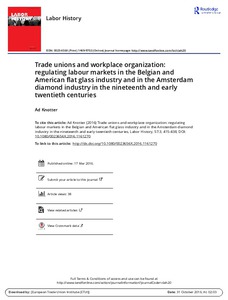Trade unions and workplace organization: regulating labour markets in the Belgian and American flat glass industry and in the Amsterdam diamond industry in the nineteenth and early twentieth centuries

2016
57
3
July
415-438
glass industry ; handicrafts ; history ; outsourcing ; trade union ; unskilled worker ; work organization
Belgium ; Netherlands ; USA
Work organization
http://dx.doi.org/10.1080/0023656X.2016.1161270
English
Bibliogr.
"In all three industries, internal subcontracting as a way to organize the workplace determined the emergence of craft unionism in the nineteenth century. In both Belgian and American window-glassmaking craft unionism, originally based on exclusion of low-skilled workers who had been underhands in the system of subcontracting, persisted well into the twentieth century, until full mechanization made artisanal glassblowing obsolete. Only then all workers could be united in an industrial union. In diamond manufacturing, craft unions were replaced by a unified industrial union already in the 1890s. In all three industries, trade unions had the biggest impact when they were able to regulate product markets and industrial competition through labour market control. Methods, time frames and duration of labour market control differed considerably, however."
Digital
The ETUI is co-funded by the European Union. Views and opinions expressed are however those of the author(s) only and do not necessarily reflect those of the European Union or the ETUI.